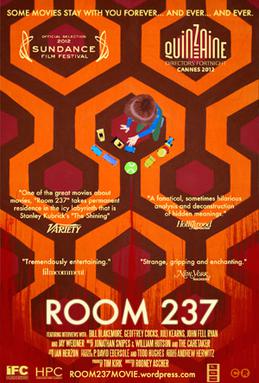In the June online issue of Static Live Magazine, I reviewed Chris McKay’s Renfield, which
premiered at the 7th Annual Overlook Film Festival: A Four Day Celebration of All Things Horror,
named after the hotel in Stanley Kubrick’s masterpiece “The Shining”. In the review, I called The
Shining “the greatest film ever made, and not because it’s a Gothic horror piece. It is not! But that’s a
story for another issue.” This…is that issue! But instead of The Shining, I chose Rodney Ascher’s
“Room 237”, a documentary released almost 32 years later, on five never-shown Kubrick scholars’
interpretations of the subtext of Kubrick’s picture. While the interviewees theories themselves range
from obvious to ridiculous, Room 237 is very well done, entertaining and thought-provoking. It
earned director Rodney Ascher two nominations in 2012 at the 65th Cannes Film Festival: Golden Camera;
and International Confederation of Arthouse Cinemas Awards.
Like any of Stanley’s films themselves, 237 is difficult to follow, especially since the interviews are
audio only. Film analyst and writer Juli Kearns’ reaction after seeing 2001 at age 10 applies here as
well: “”This is a film that’s supposed to make me think.” Like The Shining, its presented in chapters,
one of which is Boiling Down. In it, interviewee Bill Blakemore, a longtime ABC news
correspondent, says Stanley “is like a mega brain for the planet who is boiling down with all of this
extensive research, all of these patterns of our world and then giving them back to us in a dream of
a movie”. So allow me to boil the 1:42 documentary down for you, so you can concentrate on the
scholars’ arguments when you watch it, which you certainly should. The review ends with my theory
on the subtext of The Shining. I’m neither on the film nor was I remotely considered. I began my
post-retirement career as a film appreciation instructor/performance artist on 12/12/11, 42 days (a
number that plays big with Albion College history professor, Geoffrey Cocks in Room 237) before
Room 237’s release at Sundance, when I introduced “It’s a Wonderful Life” at Rave Cinemas, Southington CT.
I’ve since taught every Kubrick film, The Shining many times, including the five-
week A Comparative Analysis of King & Kubrick’s The Shining for UConn Waterbury’s OLLI Outreach Program:
Bill Blakemore – The Genocide of the American Indians: Bill argues that Stanley was
referencing the genocide of the American Indians in The Shining. It teems with Native
American imagery and a couple mentions. The novel has none.
Juli Kearns – Madness Is Maze and the Madman a Minotaur Protecting His Psyche: This is
an obvious idea.
Film writer/director/producer Jay Weidner – Kubrick Faked the Moon Landing: The Shining
hints at Stanley’s awareness of this conspiracy theory, which I do not believe.
Geoffrey Cocks – The Holocaust: Cocks makes a good argument for this idea.
Musician/film producer John Fell Ryan – Learning from the Ghosts of Our Past: I absolutely
love Ryan’s thoughts. Ryan implies The Shining is the greatest, most nuanced move ever
made. I agree.
Paulie Marino – The Duality of Man: Stanley uses almost constant symbols of twinning – the
notorious twin(ish) sisters are not in the novel – to represent our varying degrees of split
personality/double lives, mental illness, etc.
Do take a couple hours out of your day to watch this film for the first time or again, then re-watch
Kubrick’s The Shining. One of your twin personalities may never recover from the visit from this
ghost of the past. Room 237 is available on a number of streaming services, as well as DVD and
Blu-ray.
- Paul is the host for The Hub on Canal’s monthly Art in the Form of Film series. The Hub on Canal
is a non-profit art gallery/collective in New Smyrna Beach FL. His shows are sponsored by the New
Smyrna restaurant, Chases on the Beach.


